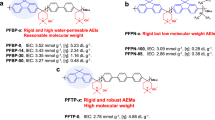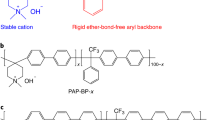Abstract
Through-plane (TP) conducting pathways in anion-exchange membranes (AEMs) are desirable for AEM fuel cells as they serve as short and efficient routes for hydroxide ion transport between electrodes, improving power output. Electric and magnetic fields have previously been used to create TP-oriented structures in AEMs, but with modest performance gains. Here we use paramagnetic ferrocenium polymers to prepare TP-oriented AEMs under a magnetic field. The magnetic field induces a mixed-valence state, which effectuates higher anion dissociation and enhanced alkali/redox stability. Our AEMs display a promising TP hydroxide conductivity of ~160 mS cm−1 at 95 °C in water, and no appreciable hydroxide conductivity loss over 4,320 h at 95 °C in alkali. The assembled fuel cells achieve a power output of 737 mW cm−2 at 80 °C and 80% relative humidity, and a durability of 3.9% voltage loss and 2.2% high-frequency resistance increase over 500 h at 500 mA cm−2, 120 °C and 40% relative humidity.





Similar content being viewed by others
Data availability
The authors declare that all data supporting the findings of this study are available within the paper and its Supplementary Information. Source data are provided with this paper.
References
Mustain, W. E., Chatenet, M., Page, M. & Kim, Y. S. Durability challenges of anion exchange membrane fuel cells. Energy Environ. Sci. 13, 2805–2838 (2020).
Chen, N. & Lee, Y. M. Anion exchange polyelectrolytes for membranes and ionomers. Prog. Polym. Sci. 113, 101345 (2021).
Gottesfeld, S. et al. Anion exchange membrane fuel cells: current status and remaining challenges. J. Power Sources 375, 170–184 (2018).
Pan, J. et al. Constructing ionic highway in alkaline polymer electrolytes. Energy Environ.Sci. 7, 354–360 (2014).
Pan, J., Chen, C., Zhuang, L. & Lu, J. Designing advanced alkaline polymer electrolytes for fuel cell applications. Accounts Chem. Res. 45, 473–481 (2012).
Li, N. & Guiver, M. D. Ion transport by nanochannels in ion-containing aromatic copolymers. Macromolecules 47, 2175–2198 (2014).
Ponce-González, J. et al. High performance aliphatic-heterocyclic benzyl-quaternary ammonium radiation-grafted anion-exchange membranes. Energy Environ. Sci. 9, 3724–3735 (2016).
Zarrin, H. et al. Quaternized graphene oxide nanocomposites as fast hydroxide conductors. ACS Nano 9, 2028–2037 (2015).
Li, N., Guiver, M. D. & Binder, W. H. Towards high conductivity in anion-exchange membranes for alkaline fuel cells. ChemSusChem 6, 1376–1383 (2013).
Mamlouk, M., Horsfall, J. A., Williams, C. & Scott, K. Radiation grafted membranes for superior anion exchange polymer membrane fuel cells performance. Int. J. Hydrog. Energy 37, 11912–11920 (2012).
Kim, J.-H., Ryu, S., Lee, J.-Y. & Moon, S.-H. Preparation of high-conductivity QPPO (quaternary-aminated poly (2,6-dimethyl-1,4-phenyleneoxide)) membranes by electrical treatment. J. Membr. Sci. 553, 82–89 (2018).
Fan, J., Zhu, H., Li, R., Chen, N. & Han, K. Layered double hydroxide–polyphosphazene-based ionomer hybrid membranes with electric field-aligned domains for hydroxide transport. J. Mater. Chem. A 2, 8376 (2014).
Chen, N. et al. Magnetic field-oriented ferroferric oxide/poly(2,6-dimethyl-1,4-phenylene oxide) hybrid membranes for anion exchange membrane applications. Nanoscale 10, 18680–18689 (2018).
Liu, X. et al. Magnetic field alignment of stable proton-conducting channels in an electrolyte membrane. Nat. Commun. 10, 842 (2019).
Liu, X. et al. Oriented proton-conductive nano-sponge-facilitated polymer electrolyte membranes. Energy Environ. Sci. 13, 297–309 (2020).
Mohanty, A. D. & Bae, C. Mechanistic analysis of ammonium cation stability for alkaline exchange membrane fuel cells. J. Mater. Chem. A 2, 17314–17320 (2014).
Marino, M. G. & Kreuer, K. D. Alkaline stability of quaternary ammonium cations for alkaline fuel cell membranes and ionic liquids. ChemSusChem 8, 513–523 (2015).
Wang, J. et al. Poly(aryl piperidinium) membranes and ionomers for hydroxide exchange membrane fuel cells. Nat. Energy 4, 392–398 (2019).
Xue, J., Liu, X., Zhang, J., Yin, Y. & Guiver, M. D. Poly(phenylene oxide)s incorporating N-spirocyclic quaternary ammonium cation/cation strings for anion exchange membranes. J. Membr. Sci. 595, 117507 (2020).
Hugar, K. M., Kostalik, H. A. T. & Coates, G. W. Imidazolium cations with exceptional alkaline stability: a systematic study of structure–stability relationships. J. Am. Chem. Soc. 137, 8730–8737 (2015).
Xue, B., Wang, Q., Zheng, J., Li, S. & Zhang, S. Bi-guanidinium-based crosslinked anion exchange membranes: synthesis, characterization, and properties. J. Membr. Sci. 601, 117923 (2020).
Liu, Y. et al. Anion exchange membranes composed of a poly(2,6-dimethyl-1,4-phenylene oxide) random copolymer functionalized with a bulky phosphonium cation. J. Membr. Sci. 506, 50–59 (2016).
Gjineci, N., Aharonovich, S., Dekel, D. R. & Diesendruck, C. E. Increasing the alkaline stability of N,N-diaryl carbazolium salts using substituent electronic effects. ACS Appl. Mater. Interfaces 12, 49617–49625 (2020).
Jang, H. et al. Anion conductive tetra-sulfonium hydroxides poly(fluorenylene ether sulfone) membrane for fuel cell application. Int. J. Hydrog. Energy 42, 12759–12767 (2017).
Zhu, L. et al. High performance anion exchange membrane fuel cells enabled by fluoropoly(olefin) membranes. Adv. Funct. Mater. 29, 1902059 (2019).
Lee, W.-H., Kim, Y. S. & Bae, C. Robust hydroxide ion conducting poly(biphenyl alkylene)s for alkaline fuel cell membranes. ACS Macro Lett. 4, 814–818 (2015).
Mandal, M., Huang, G., Hassan, N. U., Mustain, W. E. & Kohl, P. A. Poly(norbornene) anion conductive membranes: homopolymer, block copolymer and random copolymer properties and performance. J. Mater. Chem. A 8, 17568–17578 (2020).
Zha, Y., Disabb-Miller, M. L., Johnson, Z. D., Hickner, M. A. & Tew, G. N. Metal-cation-based anion exchange membranes. J. Am. Chem. Soc. 134, 4493–4496 (2012).
Kwasny, M. T., Zhu, L., Hickner, M. A. & Tew, G. N. Utilizing thiol-ene chemistry for crosslinked nickel cation-based anion exchange membranes. J. Polym. Sci. Pol. Chem. 56, 328–339 (2018).
Chen, N. et al. Cobaltocenium-containing polybenzimidazole polymers for alkaline anion exchange membrane applications. Polym. Chem. 8, 1381–1392 (2017).
Zhu, T. et al. Cationic metallo-polyelectrolytes for robust alkaline anion-exchange membranes. Angew. Chem. Int. Ed. 57, 2388–2392 (2018).
Gu, S. et al. Permethyl cobaltocenium (Cp*2Co+) as an ultra-stable cation for polymer hydroxide-exchange membranes. Sci. Rep. 5, 11668 (2015).
Zhu, T. et al. Rational synthesis of metallo-cations toward redox- and alkaline-stable metallo-polyelectrolytes. J. Am. Chem. Soc. 142, 1083–1089 (2020).
Wang, L., Peng, X., Mustain, W. E. & Varcoe, J. R. Radiation-grafted anion-exchange membranes: the switch from low- to high-density polyethylene leads to remarkably enhanced fuel cell performance. Energy Environ. Sci. 12, 1575–1579 (2019).
Mandal, M. et al. The importance of water transport in high conductivity and high-power alkaline fuel cells. J. Electrochem. Soc. 167, 054501 (2019).
Hmyene, M., Yassar, A., Escorne, M., Percheron-Guegan, A. & Garnier, F. Magnetic properties of ferrocene-based conjugated polymers. Adv. Mater. 6, 564–568 (1994).
Musgrave, R. A. et al. Main-chain metallopolymers at the static–dynamic boundary based on nickelocene. Nat. Chem. 9, 743–750 (2017).
Breuer, R. & Schmittel, M. 1,1′-Biferrocenylenes—the more redox stable ferrocenes! New derivatives, corrected NMR assignments, redox behavior, and spectroelectrochemistry. Organometallics 31, 1870–1878 (2012).
Tabbì, G. et al. Water stability and cytotoxic activity relationship of a series of ferrocenium derivatives. ESR insights on the radical production during the degradation process. J. Med. Chem. 45, 5786–5796 (2002).
Pavlishchuk, V. V. & Addison, A. W. Conversion constants for redox potentials measured versus different reference electrodes in acetonitrile solutions at 25 °C. Inorg. Chim. Acta 298, 97–102 (2000).
Gray, H. B., Sohn, Y. S. & Hendrickson, N. Electronic structure of metallocenes. J. Am. Chem. Soc. 93, 3603–3612 (1971).
Brown, G. M. et al. Oxidation-state and electron-transfer properties of mixed-valence 1,1′-polyferrocene ions. Inorg. Chem. 14, 506–511 (1975).
Talham, D. R. & Cowan, D. O. Application of the PKS vibronic coupling model to mixed-valence ferrocene derivatives, biferrocene and bis(fulvalene)diiron. Organometallics 3, 1712–1715 (1984).
Hewson, A. C. & Newns, D. M. Polaronic effects in mixed and intermediate-valence compounds. J. Phys. C 12, 1665–1683 (1979).
Rudie, A. W., Davison, A. & Frankel, R. B. A high-field Moessbauer study of the iron sites in mixed-valent biferrocene monocation. J. Am. Chem. Soc. 101, 1629–1631 (1979).
Kirchner, R. F., Loew, G. H. & Mueller-Westerhoff, U. T. Theoretical study of the electromagnetic properties of bis(fulvalene)diiron in its three oxidation states. Inorg. Chem. 15, 2665–2670 (1976).
Cohn, M. J., Timken, M. D. & Hendrickson, D. N. Moessbauer spectroscopy of mixed-valence biferrocenes in high magnetic fields. J. Am. Chem. Soc. 106, 6683–6689 (1984).
Varcoe, J. R. et al. Anion-exchange membranes in electrochemical energy systems. Energy Environ. Sci. 7, 3135–3191 (2014).
Zhegur-Khais, A., Kubannek, F., Krewer, U. & Dekel, D. R. Measuring the true hydroxide conductivity of anion exchange membranes. J. Membr. Sci. 612, 118461 (2020).
Douglin, J. C., Varcoe, J. R. & Dekel, D. R. A high-temperature anion-exchange membrane fuel cell. J. Power Sources Adv. 5, 100023 (2020).
Thompson, S. T., Peterson, D., Ho, D. & Papageorgopoulos, D. Perspective—the next decade of AEMFCs: near-term targets to accelerate applied R&D. J. Electrochem. Soc. 167, 084514 (2020).
Dekel, D. R., Rasin, I. G., Page, M. & Brandon, S. Steady state and transient simulation of anion exchange membrane fuel cells. J. Power Sources 375, 191–204 (2018).
Muller, J., Zhegur, A., Krewer, U., Varcoe, J. R. & Dekel, D. R. Practical ex-situ technique to measure the chemical stability of anion-exchange membranes under conditions simulating the fuel cell environment. ACS Mater. Lett. 2, 168–173 (2020).
Acknowledgements
The authors thank the National Natural Science Foundation of China (21875161 and 22005214). The authors also thank the National Key Technology R&D Program (2018YFB0105601), the Natural Science Foundation of Tianjin (17JCZDJC31000) and the State Key Laboratory of Engines for financial support. A portion of this work was performed on the Steady High Magnetic Field Facilities (SM1 superconducting magnet), High Magnetic Field Laboratory, Chinese Academy of Sciences (Hefei, China). The authors thank researcher Jun Fang at the High Magnetic Field Laboratory for operating the SM1 superconducting magnet during the membrane casting process. D.R.D would like to thank the financial support of the Nancy & Stephen Grand Technion Energy Program (GTEP), and of Planning & Budgeting Committee / ISRAEL Council for Higher Education (CHE) and Fuel Choice Initiative (Prime Minister Office of ISRAEL) within the framework of “Israel National Research Center for Electrochemical Propulsion (INREP)”.
Author information
Authors and Affiliations
Contributions
M.D.G. and X.L. conceived the study. M.D.G. and X.L. designed the experiments. M.D.G., D.R.D., Y.Y., J.Z. and X.L. wrote the manuscript. X.L., N.X., J.X., M.L. and C.Z. carried out the experiments and collected the data. X.L., N.X. M.L. and C.Z. prepared the data graphs. M.D.G., D.R.D., Y.Y., J.Z., Y.Q. and X.L. discussed the results. All authors commented on the manuscript.
Corresponding authors
Ethics declarations
Competing interests
The authors declare no competing interests.
Peer review
Peer review information
Nature Energy thanks Christopher Arges, Patric Jannasch and Pawel Majewski for their contribution to the peer review of this work.
Additional information
Publisher’s note Springer Nature remains neutral with regard to jurisdictional claims in published maps and institutional affiliations.
Supplementary information
Supplementary Information
Supplementary Figures 1–11, Notes 1–7, Tables 1–16 and Refs. 1–69
Source data
Source Data Fig. 2
Statistical Source Data.
Source Data Fig. 3
Statistical Source Data.
Source Data Fig. 4
Statistical Source Data.
Source Data Fig. 5
Statistical Source Data.
Rights and permissions
About this article
Cite this article
Liu, X., Xie, N., Xue, J. et al. Magnetic-field-oriented mixed-valence-stabilized ferrocenium anion-exchange membranes for fuel cells. Nat Energy 7, 329–339 (2022). https://doi.org/10.1038/s41560-022-00978-y
Received:
Accepted:
Published:
Issue Date:
DOI: https://doi.org/10.1038/s41560-022-00978-y
- Springer Nature Limited
This article is cited by
-
Upscaled production of an ultramicroporous anion-exchange membrane enables long-term operation in electrochemical energy devices
Nature Communications (2023)
-
Aligned for renewable power
Nature Energy (2022)





